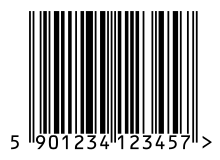How GS1 standards work
GS1 standards create a common foundation for business by uniquely
identifying, accurately capturing and automatically sharing vital information
about products, locations, assets and more. Businesses can also combine
different GS1 standards to streamline business processes such as traceability.
GS1 standards create a common foundation for business by uniquely
identifying, accurately capturing and automatically sharing vital information
about products, locations, assets and more. Businesses can also combine
different GS1 standards to streamline business processes such as traceability.
Identify
GS1 identification standards include standards that define unique identification
codes (called GS1 identification keys) which may be used by an information
system to refer unambiguously to a real-world entity such as a:
- trade item
- logistics unit
- physical location
- document
- service relationship
- other entity
Capture
GS1 data capture standards currently include definitions of bar code and
radio-frequency identification (RFID) data carriers which allow
GS1 Identification Keys and supplementary data to be affixed directly to a
physical object, and standards that specify consistent interfaces to readers,
printers, and other hardware and software components that connect the data
carriers to business applications.
radio-frequency identification (RFID) data carriers which allow
GS1 Identification Keys and supplementary data to be affixed directly to a
physical object, and standards that specify consistent interfaces to readers,
printers, and other hardware and software components that connect the data
carriers to business applications.
Share
GS1 standards for information sharing include data standards for master data,
business transaction data, and physical event data, as well as communication
standards for sharing this data between applications and trading partners.
Other information sharing standards include discovery standards that help
locate where relevant data resides across a supply chain and trust standards
that help establish the conditions for sharing data with adequate security.
business transaction data, and physical event data, as well as communication
standards for sharing this data between applications and trading partners.
Other information sharing standards include discovery standards that help
locate where relevant data resides across a supply chain and trust standards
that help establish the conditions for sharing data with adequate security.
Use
Businesses can also combine different GS1 standards to streamline business
processes such as traceability.
processes such as traceability.

